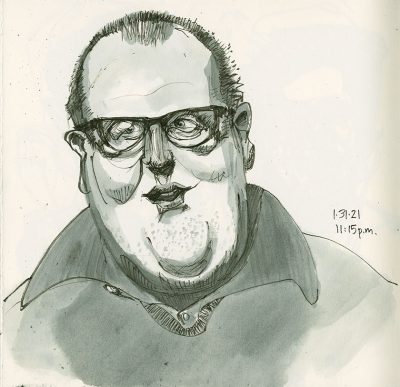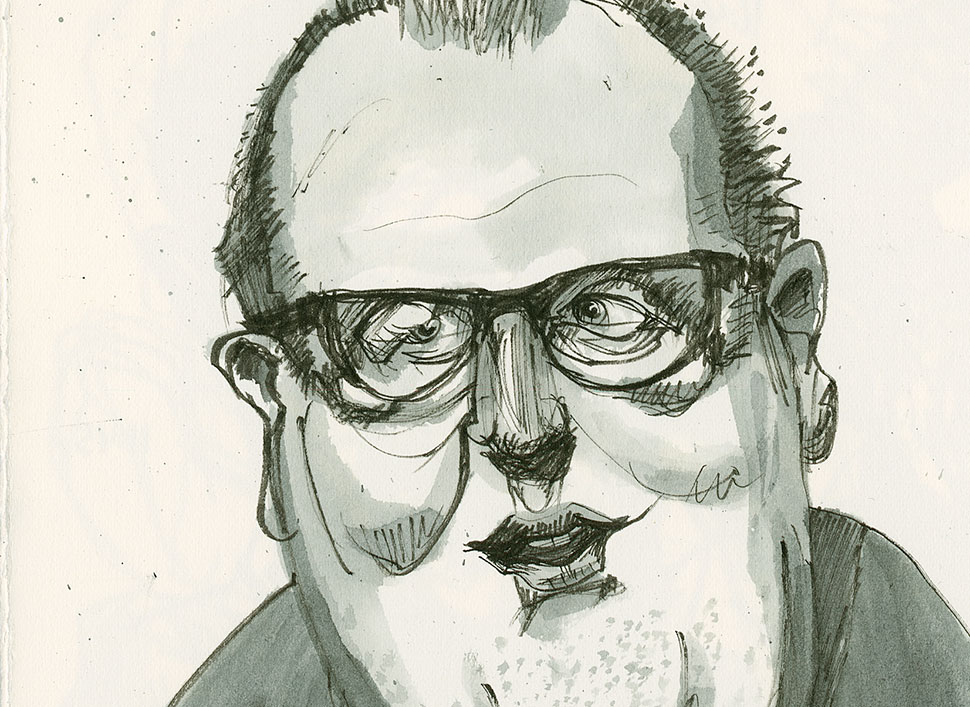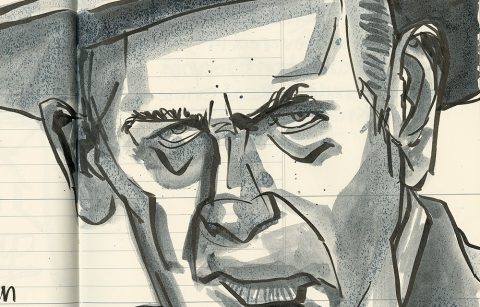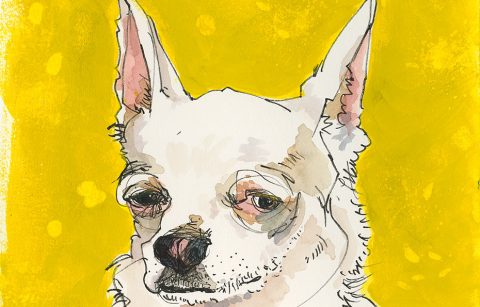 This is another comic guest from “As Yet Untitled with Alan Davies.” I’m sorry I don’t remember his name, the book is in storage. A lovely 8 x 7.5 inch journal that always seems a perfect size to me.
This is another comic guest from “As Yet Untitled with Alan Davies.” I’m sorry I don’t remember his name, the book is in storage. A lovely 8 x 7.5 inch journal that always seems a perfect size to me.
I used brush pen and ink wash on this sketch. And I did pause the TV for this sketch (unlike the previous post), because I wanted to take time and play with the washes and establish the values in a more orderly fashion.
While it’s certainly still possible to make nice ink washes on the current Fabriano Artistico watercolor paper, now that it’s made using vegetable sizing you have to work harder to get the smoothness. And so here I made that work for me by making deliberate stroke-i-ness on the collar. (I bought this paper after the change was made, not knowing until I used it that the sizing had been changed. It sat in my flat file for years until I finally bound it into journals for quick sketching.)
Regardless of the paper you’re working on there is something really fun about monochromatic drawings.
Be sure to let your paper manufacturers know that you LOVE GELATIN sizing for watercolor and wet media papers. Fluid 100, ThSaunders/Waterford, and Arches all still use gelatin sizing (as of this posting—it could change in a flash). If we don’t speak up, it will disappear, and with it, a tradition that’s hundreds and hundreds of years old (introduced by Fabriano in the middle of the 13th century); and common to papers of the great age of watercolor—1775 to 2000.























Roz, I suspect the shift away from gelatin sizing is at least partially related to reducing a paper mill’s carbon footprint, expect gelatin sizing to disappear in the near future. As much as I like gelatin sized papers too, I’ll gladly do without to help avoid the worst effects of human induced global warming. Love the monochrome sketch👍👍.
Paul, you know I love you, but you aren’t a watercolorist so you don’t have any skin (no pun intended) in this particular game. If you’d grown up watercoloring on gelatin-sized paper I know you’d still have your great scruples but any thoughts in this vein would be a good deal more tortured.
I believe there are ways to continue to have gelatin sizing for watercolor paper without destruction of the environment. It should be on the table to discuss and work out, especially since people universally haven’t shifted to vegan lifestyles there are still bi-products and waste from raising animals. The material used for gelatin is a bi-product of the animal husbandry industry so using those materials is actually a way to have less waste.
I think it’s a matter of non-art companies buying art materials companies and caring only about the bottom line in cost of producing materials, and in their public face for the world community, especially non-artists, or people who haven’t worked with other materials and don’t know the difference.
I know that it will be more and more difficult to get gelatin-sized watercolor paper as my life winds down to its conclusion. And my grief over this is not just selfish, that I won’t have more paper to use, but for artists I’ve trained and those coming up behind them, who will never know what it’s like and will be several more degrees removed from the creation of art they might enjoy viewing in museums. I think it’s very very sad.
But then I sobbed very audibly throughout the Linotype movie.
Thanks for this info. I was just trying to figure out why I hate the newer w&n paper as well as the changes to fabriano artistico and though I knew it was something to do with the sizing I couldn’t figure it out. You are the only website I came across mentioning gelatin vs vegetable/starch sizing and that is definitely the problem. I could maybe manage the Fabriano but the wn is awful which is unfortunate as I really like the texture of it. I don’t know how to technically describe the problem but it really changes the medium. Every watercolorist discovers the beauty of a well laid single, undisturbed brushstroke and I just can’t get that on these nongelatin sized papers.it really does change what watercolor is to me so I’m with you -if there ever needs to be a petition or protest! ;). (I’m of the mindset that we should focus on big policy changes and not individual lifestyle (or individual market) changes if we want real sustainability going forward ). My fav paper now is Saunders and second is arches. Anyway, just wanted to say thanks for the info!
Nancy, it’s very difficult for those of use who love gelatin sized watercolor papers. The paper makers don’t seem to be taking those of use who are using the paper into consideration. Having to work on vegetable and synthetic sizing has really changed the way we can work.
Sadly I don’t think your desire to sign a petition (which I surely would) and your “mindset of going forward on bit policy changes not individual lifestyle (or individual market” changes if we want real sustainability going forward” will probably be mutually exclusive in this area. Those of us who love gelatin sized papers are probably a dwindling group because since 2020 most papers have changed and it’s on those changed papers that a whole new generation of watercolorists have learned. The rest of the world probably doesn’t care about us. And many would argue that to have less livestock in the world (the source for gelatin) would be a good thing because of global warming issues and pollution, and also general health (people eating too much meat and fat). So many will argue that sustainability lies in a different direction from where you and I and other watercolorists would like it to go.
We can hope, we can speak out. I think it needs to be a priority, but then if I were in charge of the world I wouldn’t have let almost all the linotype machines get junked—so obviously I have some pet interests.
In the meantime I agree with you on the TH Saunders/Waterford. I was sketching earlier today on some and I practically swooned because of the lovely gelatin sizing odor and the fun of painting on it. I wish everyone could have that and there would be a crowd in front of every paper mill.
If you haven’t tried Fluid 100 (their 100 percent cotton, gelatin sized watercolor paper, not the student grade stuff they first came out with) you might give it a go and enjoy it, as I mentioned in the post.
Also, I frequently add Langton-Prestige paper. You can read about it here. https://rozwoundup.com/2021/06/testing-langton-prestige-watercolor-paper.html
One of my students drew it to my attention last year and I did a test and I like it. Read the full post because they have a different, lower grade paper too that has similar packaging and is similarly named.
The downside to that paper is that it isn’t available locally (for me) and so it’s a bit pricey.
But it’s one to add to your gelatin sized paper list.
If I find more I’ll be sure to post—if you find more brands that are using gelatin sizing, please write to me!
Hang in there and enjoy the papers you can find.
And remember, if things get really bad, we could always apply surface gelatin sizing to our sheets of paper. It would be a mess, and I have little studio space now. But it would be perhaps worth it.
Roz,
I read your recent posts on changes to the quality of sizing in paper. Unfortunately, materials change or disappear — and this often the case for me whenever I learn about a great paper or tool from the past. (As I learned just last week when I stumbled on info about the joys of Stabilo Tone crayons, only to find they’re discontinued.)
In “The Pen & Ink Book,” Joseph Smith explains how to size your own paper using grocery store gelatin. I have not yet tried this, but I just picked up a box of 4 envelopes for a dollar. (I’ve seen other formulas that include adding alum for a stronger surface.)
Smith explains methods for applying a surface size to any paper, which should work for paper blocks. He also describes deeper sizing by soaking sheets of paper in a tray.
Have you ever tried this? If so, how did it turn out?
Doug, Sorry you only recently learned about StabiloTones. I’ve been whining about them for years. If you can make do with a smaller (18) color palette, the Woody line is the same. (Sadly it doesn’t contain my essential colors.)
I have J. Smith’s pen and ink book but it is in storage and I’m not likely to see it until 2023—I don’t recall anything he wrote on the subject of gelatin. (At the time I first read that book I had at least 10 favored watercolor papers that were gelatin sized. Nine of which were suitable for binding.)
I have never wanted to try sizing paper. Paper making is a rather involved skill that best starts with the choice of fibers and the preparation of those fibers in a process that can be repeatable to yield consistent results—ditto for the process of then creating a sizing mixture that will create the results that you want consistently.
People interested in making their own papers with gelatin sizing can rent beater time and wet room time at MCBA (you need to be a member and have some training with the equipment; requirements may have changed in the last few years as to which hoops you need to jump through).
For me watching papers die has always been distressing, but there have always been a couple good remaining papers. Because of that it has not been appealing to me to make paper, or even apply sizing on existing poorly sized paper, because quite frankly I’d rather be sketching and painting than doing all that development work and then frankly all that physical paper making work.
If I were 22 and knew what I knew now about what would happen to papers in my life time I might have put the time into doing that, but then I would have missed out on having the pups; all in all I think I prefer the way things turned out.
I’ll keep using what I have until it’s gone, and then use non-art papers, as I often do already, because I enjoy some of them so much.
If things get really bad in the paper realm I might start working digitally using the iPad and Procreate.
It’s only recently, because of storage problems and the use of blocks at the Minnesota State Fair some years, that I’ve used blocks of paper or pads much at all. I prefer to purchase paper in sheets as the surface of the paper is compressed in the blocking and padding process. So it wouldn’t even be worth it to me to try and apply new sizing to blocks or pads of paper because they are already not even approaching ideal to me. Applying sizing to a full sheet would make more sense to me, but not enough sense for me to put up with the physical effort of trying to create a uniform sizing on such a large sheet. Too many negatives all around.
If you ever do give sizing a try, please give me a shout and let me know. Ditto if you decide to throw all your efforts at this and develop your own gelatin sized paper available in sheets.
I would research it a bit more though. I’m sure J. Smith has got some great approach (though why he felt the need to do this in the 1980s and 1990s when we had so many gelatin sized papers is an interesting question to me and I can’t wait to get my copy of his book out so that I can review what about his ink methods he felt he needed to do this for). HOWEVER, the alum tip sounds like a good one and if someone is suggesting that I would find out more about it if I were you. Something about reading that in your comment puts a little memory bell ringing in my brain. Maybe something Denny Ruud (a bookbinder and calligrapher) said in a marbling class? I believe it’s used in creating the color baths. I don’t know, it just seems like alum needs to be in there.
You have my deepest wishes for success.
Doug, here’s my 3rd response to your recent comment. I had to dig a little more and found this interesting page on historical paper making and the use of alum and rosin etc.
http://www.wovepaper.co.uk/alumessay3.html
And I’m wondering too, as I try to drag my memory, but didn’t J. Smith add gelatin as a resist in his techniques which is a totally different purpose to what you’re embarking upon??? Or maybe I’m not remembering at all, since it has been decades since I’ve read his book.
Doug, this is reply 2 to your recent comment. Having written back to you I couldn’t leave it alone and had to check into the whole ALUM thing.
I found this https://cool.culturalheritage.org/byorg/abbey/an/an17/an17-4/an17-407.html
In sections A.2 and A.3 the author of that page writes about alum having a hardening effect. You definitely want that!!! They are using the alum to harden the surface and prepare it for the gelatin.
I think what is coming back to me for marbling is that the alum is in the paint bath to allow for the SMOOTH and complete application of the paint on the paper to be marbled.
So in section A.3 you’ll see alum can also change pigment colors if you use too much, but at the same time, later in the page it talks about influencing the brightness of the colors.
So there is a lot going on here, but I would guess that the alum bath first, allowed to dry, will create a surface that is good for an EVEN APPLICATION of the gelatin, because without an even application of gelatin all efforts would be worthless and you wouldn’t enjoy working on that paper at all.
Anyway, I suggest you check out that page of historical use, before you start your experiments. It might point you, though footnotes, to some really useful process information.
Good luck. Happy sleuthing.
It is tragic that the exquisite old Fabriano watercolor paper (especially the 300lb hot pressed) has gone extinct. The entire community of botanical and natural science illustrators have been in turmoil ever since the change. Many rushed to vellum. Others still search for alternatives that simply do not exist. Heavyweight hot pressed watercolor papers are vanishing. It appears that the young folks will never know it existed, just like we will never experience the exquisite Samarkand papers of centuries past.
These cultural extinctions are serious and limit what human culture can create and leave for posterity.
Re-sizing paper is the only option I see going forward.
We are definitely moving in that direction. I think it might still be possible if everyone who paints in watercolor and cares about this made an en masse STINK to the paper companies, specifically those that haven’t converted yet. Are you in Britain? If so the Royal Watercolor Society might be trying to make some sort of concerted effort about this you could look into. And of course ask all the watercolorists you know. I’m about ready to beg people to be vocal about this.
Things change. I know that more than most. I’ve made it my life’s pursuit to document these changes in several different fields. I know it’s not the end of the world.
For me, the marvel of paper for watercolor was 1754 (early 1750s anyway) what James Whatman invented WOVE PAPER and changed the paper world forever.
No more laid lines, and a wonderful gelatin sizing allowed watercolor paint to move freely across the paper, float on the sizing and dry in slower manner so that both glazes and simply the natural transparency of the paper could allow the true beauty of paint on paper to come through.
What more could you ask?!!!
It’s a great sadness to me that new artists will never know the joy of moving paint around on a truly marvelous paper.
If you’re in a botanical society see you if you can convince them to talk to paper manufacturers. (Any mill in the EU is probably a no-go as to be animal product free seems to be a political necessity there, hence Hahnemühle has been for years and those being purchased will be changed.) I have another post on this coming up. A sad one.
In the not to distant future. A younger watercolor artist will look at a older painting done on gelatin sized paper by another artist and wonder how did that effect happen? I can’t do that. Just maybe this paper change will wipe out the whole watercolor media. Artist will just stop trying.
Allen, it’s already happening now. Students of mine who’ve never painted and are learning on veg. and starch sized watercolor papers are very frustrated when drying to do some of the things they see traditional watercolorists do with glazes.
Things change and that’s inevitable. I’m grateful I got in on the last few decades of what was a almost a half millennium run.
Already in some art history books where art critics are writing about techniques (but don’t understand the techniques because they aren’t artists themselves) there are horrible errors in their discussion of technique.
But these aren’t going to be the windmills that I spend my last years tilting towards. I’ll just keep commenting on the paper.
On the positive side, for those intrepid your watercolorists, while they look and try to deconstruct the circumstances and the materials that allowed certain effects but won’t be able to replicate them they will nevertheless learn valuable lessons that push their art and methods forward with available materials.